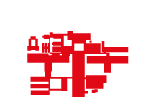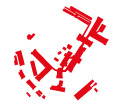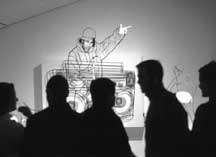:: Wednesday, June 15, 2005 ::
ART AND MOBILE TECH::PROJECT REVIEWS
RAP AND MAPS: BETWEEN NETWORKS AND THE REAL
BY: Molly Hankwitz EXIBITION:CITY/OBSERVER
EXIBITION:CITY/OBSERVER
Curated BY: Yukie Kamaya
Yukie Kamaya's City/Observer 2005 exhibition brings together 5 intriguing works in'an opportunity for the artists to experiment with the Internet as a platform for their art practice', the curator writes.
'Urban' is located in a context between the 'virtual' and the 'real' or 'physical'. Moreover, the exhibition invited participation from artists and architects who 'have migrated to and from multiple cities'. Kumaya writes: 
Their moves inspire them to observe new environments from alternative perspectives and to become catalysts for exploring relationships between cities and people.
One of the artists, Heman Chong, developed 100 Aerial Views, in which he maps satellite photos of footprints of Singaporean buildings to their real addresses. This draws upon the subject of maps and locations, or spaces between the literary/imagined and the real, and as interrelated via networks and as artefacts of digital culture which, in its mobility is both 'networked' and 'detached.' Chong's work speaks to spaces which cannot be articulated by 'normal' maps but which exist as maps among and for their users in a social and political environment, recalling the Situationists' maps of the 'Naked City' which challenged the commodificaiton of Paris through a re-routing of the idea of 'map' as something generated from personal exploration or experience. Kuyama writes:
Mapping physical urban sites into digital forms and transforming the existing volumes of buildings into flat pictograms, Chong challenges the historical, topographical and political restrictions of the city, deconstructing them across computers around the world.

City/Observer includes works which observe the city from its details and debris and which redress urban space from random, invisibilized, and unspoken perspectives. 'Mobility' in this process augments 'poetically' our understanding of the deeper complexities of contemporary life; complexities inscribed by the trans-cultural and trans-national.
City/Observer website
:::::

PROJECT::FREE 2 TALK?
BY:Thomas Charveriat
in collaboration with Frank Plant
What is 'argot'? It is at the same time nation and language. It's a coalition between people and speech. A hundred and fifty years ago, when Victor Hugo introduced in 'Les Miserables', a character using slang, there was a lot of commotion amongst the readers. '-What? How? Argot? Argot is horrible, it is despicable!.
Free 2 Talk is a curious project exploring SMS txting and this notion of 'argot' first exhibited at the Centre for Contemporary Culture in Barcelona in 2003, F2T is a perceptive outlook on the proliferation of SMS, the reception- there are an estimated 25 billion such messages sent around the world daily- and enjoyment of SMS by the public. The installation explores 'the ways technology shapes the development of language, particularly new forms of slang' through sculpture, robotics, and hip hop. Viewers interact directly with components of the artwork by txting it from their mobile. The messages are then scanned for frequently used words and when found, this phenomenon triggers the sculptural components into action intermixing the presence and use of mobile communication with daily life, pop icons such as boom boxes and cars, and especially the lyrics of 'the rapper.' (in collaboration with rapper Jim Barnard, Amsterdam)
For the people who still ignore its meaning, 'argot' is a conjunction between a literary phenomenon and its social consequence. SMS language (Short Message Service), would have surprised Victor Hugo : 'will spk 2 u l8r ' (I will speak to you later.) or 'wan2tlk' (Want to talk?). About eight and a half million messages like these run daily through Spanish mobile phones...
F2T website
All quotes taken from artists' statement.